Are you curious about the value of a 1958 quarter? You’ve come to the right place! This comprehensive guide will provide you with all the information you need to accurately assess your coin’s worth.
I’ll dive into the various factors that influence the value of individual coins, explore the significance of different Mint errors to collectors, and uncover the fascinating history and design of this particular quarter. So, let’s embark on this numismatic journey!
Value Chart for 1958 Quarter
| Mint Mark | XF45 | MS60 | MS65 | MS67 |
|---|---|---|---|---|
| 1958 No Mint Mark Quarter Value | $6 | $10 | $28 | $100 |
| 1958 D Quarter Value | $6 | $10 | $34 | $200 |
| PR60 | PR65 | PR67 | PR69 | |
| 1958 No Mint Mark Proof Quarter Value | $8 | $24 | $34 | $190 |
| Deep cameo: $20 | Cameo: $28 | Cameo: $55 | Cameo: $950 | |
| Deep Cameo: $130 | Deep Cameo: $225 | Deep cameo: $7,750 |
History of the 1958 Quarter
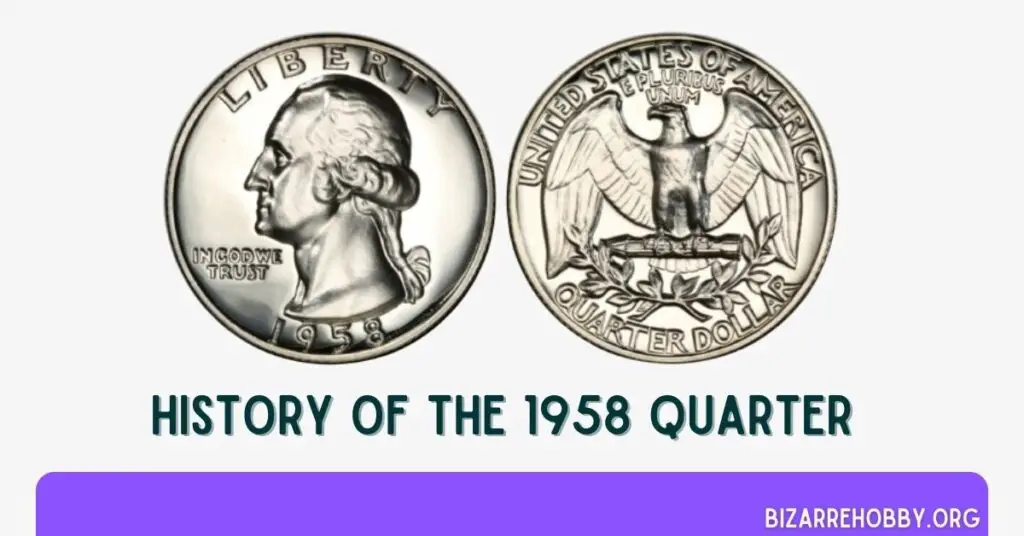
The 1958 quarter is part of the long-running Washington quarter series, which began more than two decades earlier. This iconic coin derives its name from the portrait of George Washington prominently featured on its obverse side.
The Washington quarter series was inaugurated in 1932 to commemorate the bicentennial of George Washington’s birth. These quarters were initially composed of 90% silver and 10% copper, a composition that remained constant for over three decades.
It wasn’t until 1965 that the coin’s composition changed due to rising silver prices. From that year onwards, circulating quarters were manufactured using a copper core with a copper-nickel cladding. However, some proof versions continued to be struck in silver for collectors.
In recent years, the quarter has undergone numerous design changes on its reverse side, including the popular 50 States and America the Beautiful series. However, the 1958 quarter maintained the original design that had been in use since the series’ inception.
The year 1958 saw the production of business strike quarters at both the Philadelphia and Denver Mint facilities. Additionally, the Philadelphia Mint produced proof coins for collectors. Quarters minted in Denver bear a “D” mint mark on the reverse, while those from Philadelphia lack a mint mark, as was customary at the time.
Features of the 1958 Quarter
Now lets take a look at some of the most prominent features of the 1958 quarter. We will look at the obverse and reverse design as well as talk about some technical specifications of the 1958 quarter.
Obverse Design of the 1958 Quarter
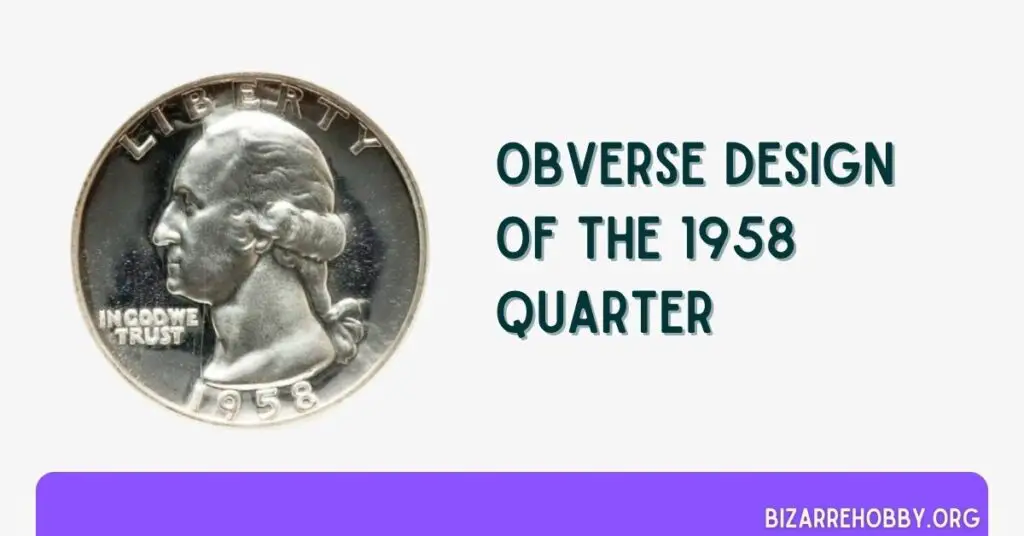
Numismatists refer to the “heads” side of a coin as the obverse. The 1958 quarter’s obverse features the same portrait of George Washington that graced the coin from 1932 to 2022. This enduring design was created by sculptor John Flanagan, though its selection wasn’t without controversy.
Initially, plans were made to honor Washington with a commemorative half dollar to be produced for a single year. A special committee overseeing the bicentenary celebrations was expected to choose the design. However, plans changed, and it was decided that Washington would appear on the quarter as a permanent fixture of American coinage.
This change meant that the final decision on the design fell to the Treasury Department. The Bicentennial Committee had already selected a portrait by Laura Gardin Fraser and advocated for its use. However, Treasury Secretary Andrew Mellon preferred Flanagan’s design.
Despite Mellon’s departure before the coins were issued, his successor, Ogden Mills, upheld the decision despite the committee’s appeals. This choice has sparked debate among numismatists for decades, with many arguing that Fraser’s design was superior.
Flanagan’s initials can be found on the cut-off at the base of the portrait. To the left of the portrait is the motto “IN GOD WE TRUST,” while “LIBERTY” curves above it. The date is inscribed at the bottom of the coin, parallel to its edge.
Reverse Design of the 1958 Quarter
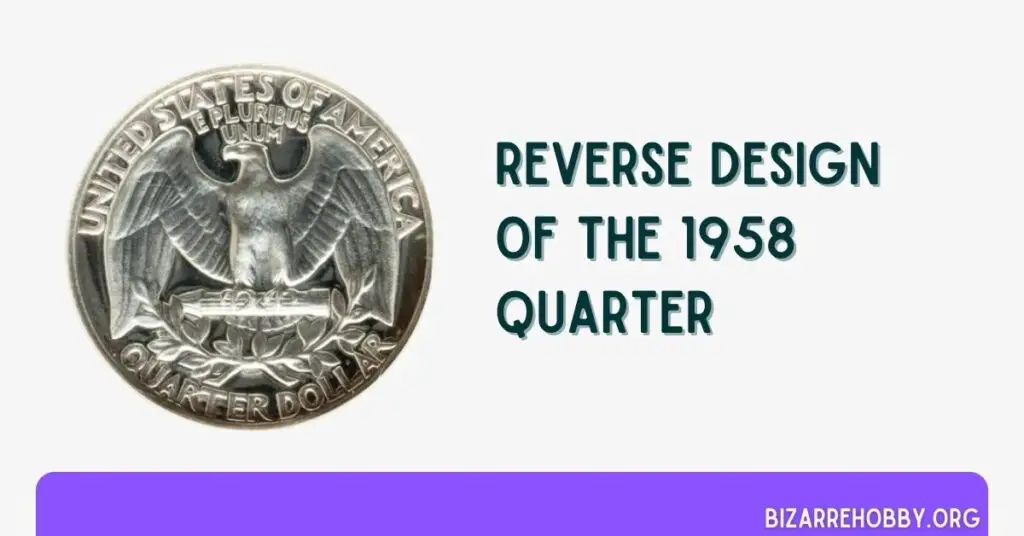
Like the obverse, the reverse of the 1958 quarter was designed by John Flanagan. It features a heraldic eagle with outstretched wings, perched atop a bundle of arrows. This powerful imagery symbolizes strength and readiness.
Below the eagle, an olive branch curves along the lower edge of the coin, representing peace. This juxtaposition of symbols reflects the nation’s desire for peace while maintaining preparedness.
The phrase “E PLURIBUS UNUM” arches over the eagle’s head. This Latin motto, meaning “Out of many, one,” references the united nature of the country formed from individual states.
The country name “UNITED STATES OF AMERICA” curves along the top of the design, while the denomination “QUARTER DOLLAR” mirrors it at the bottom.
If your coin has a mint mark, you’ll find it on the reverse. Look for a small letter below the olive branch and above the “R” in “QUARTER.” A “D” indicates the coin was struck in Denver, while the absence of a mint mark signifies it was produced in Philadelphia.
Technical Specifications of the 1958 Quarter
The 1958 quarter, being part of the silver series, weighs slightly more than its clad counterparts introduced in 1965. It tips the scales at 6.3 grams, compared to the 5.67 grams of clad quarters. Despite this weight difference, both versions share the same diameter of 24.3 millimeters.
One notable feature of the 1958 quarter is its “reeded edge.” When viewed from the side, you’ll notice a series of parallel grooves running perpendicular to the coin’s faces. These reeds serve both aesthetic and practical purposes.
Historically, reeded edges were introduced in the 18th century as a safeguard against “coin clipping,” a fraudulent practice where unscrupulous individuals would shave off small amounts of precious metal from coin edges. The presence of reeds made such tampering immediately noticeable, helping to maintain the integrity of the coinage.
All in all, the 1958 quarter is a fascinating piece of American numismatic history. Its silver content, classic design, and potential for valuable errors make it a sought-after coin among collectors. Whether you’re a seasoned numismatist or a curious newcomer, the 1958 quarter offers a window into the rich tapestry of American coinage.
1958 Quarter Grading Guides
| Grade Number | Grade |
|---|---|
| 1 | Basal State-1 |
| 2 | Fair |
| 3 | Very Fair |
| 4, 5, 6 | Good |
| 7, 8, 10 | Very Good |
| 12, 15 | Fine |
| 20, 30 | Very Fine |
| 40 | Extremely Fine |
| 50 | About Uncirculated |
| 60 | Mint State |
| 65 | Mint State |
| 70 | Mint State |
Please check out my detailed article on how to grade Washington quarters to understand the grading scale and the exact grade of your 1958 quarter.
1958 Quarter Value Guides
Understanding the value of your 1958 quarter is essential for both collectors and casual coin enthusiasts. The worth of these coins can vary significantly based on several factors, including mint location, condition, and the presence of any unique errors.
1958 No Mint Mark Quarter Value
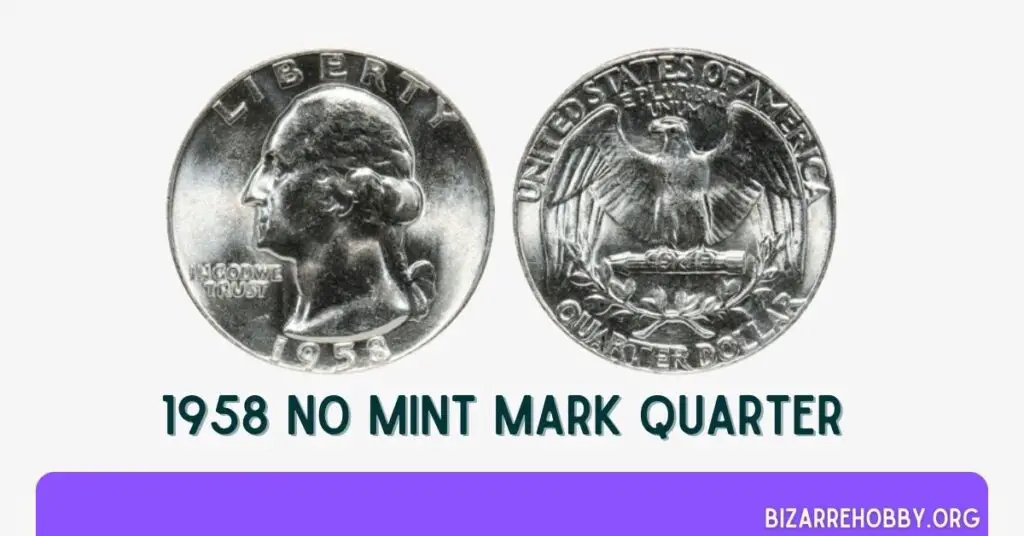
The Philadelphia Mint produced approximately 6.36 million quarters in 1958. Numismatists estimate that roughly 10% of these coins have survived to the present day.
While this may seem like a substantial number, the value of individual coins varies significantly based on their condition. Coin condition is measured on a scale from 1 to 70, with 1 representing the poorest condition and 70 indicating a perfect specimen.
All 1958 quarters without a mint mark have inherent value due to their silver content. According to the Professional Coin Grading Service (PCGS), coins graded from PO1 (“poor”) to XF45+ (“extremely fine”) are valued at approximately $6.
For uncirculated coins, also known as “mint state” (MS), values start around $10 for an MS60 grade. The price increases steadily with condition, reaching about $28 for an MS65 grade.
The most exceptional example known to date is an MS68 grade, certified by the Numismatic Guaranty Corporation (NGC). This coin last appeared at public auction in 2008, fetching an impressive $4,060.
1958 D Quarter Value
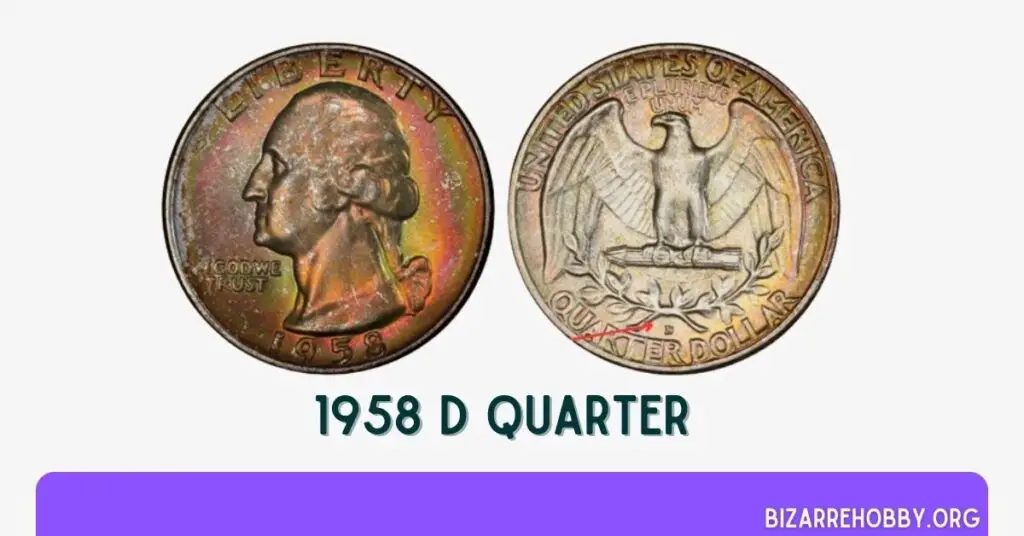
The Denver Mint facility was particularly prolific in 1958, striking over 78 million quarters. These coins can be easily identified by the small “D” mint mark on the reverse.
Values for circulated 1958-D quarters are comparable to their Philadelphia counterparts. Coins graded between 1 and 45+ are typically worth around $6, while those graded 50 to 59 (“about uncirculated”) range from $7 to $9.
Mint state coins start at $10, with gem-quality MS65 specimens valued at approximately $34. The value increases dramatically for higher grades, with MS67 coins worth around $200. The PCGS has certified 51 coins at MS67+, valuing each at $800.
The pinnacle of 1958-D quarters are those graded MS68. Only six coins have achieved this grade, each carrying a remarkable value of $8,500.
1958 No Mint Mark Proof Quarter Value
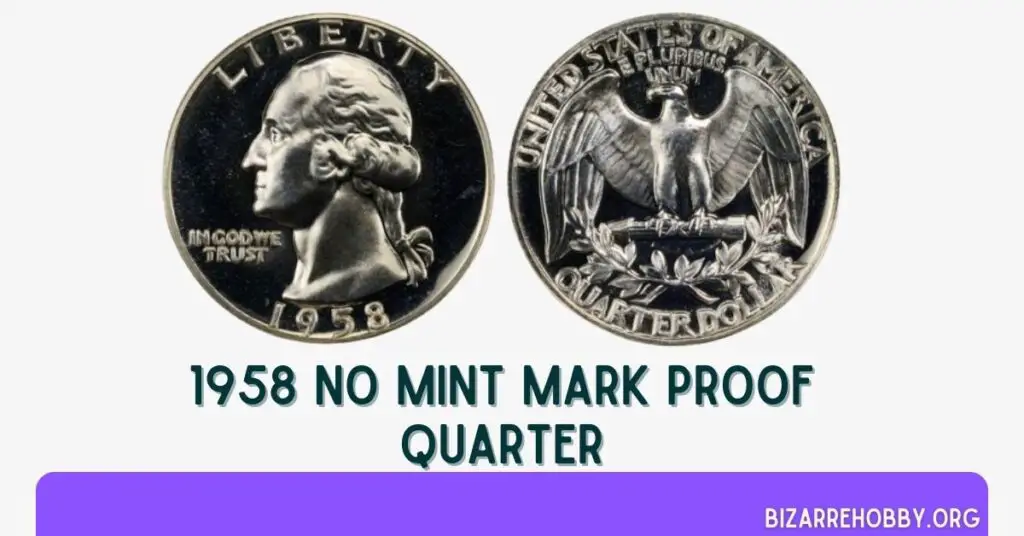
In addition to business strike coins, the Philadelphia Mint also produced proof quarters in 1958. While neither variety bears a mint mark, proof coins are distinguished by their highly reflective surfaces.
Like their business strike counterparts, 1958 proof quarters were composed of 90% silver. However, these coins were struck using specially prepared dies on highly polished planchets, resulting in superior detail and finish.
Originally, proof coins were primarily produced for coin records and archives. However, by 1958, coin collecting had gained significant popularity, leading to increased proof coin production for collectors. The Philadelphia Mint struck 875,652 proof quarters that year.
Today, the PCGS estimates that only about 25,000 of these proofs have survived. Given their intended purpose, all surviving proofs are graded at least PR60. Prices for standard examples at this lowest grade start at $8.
Some proof coins are designated as cameos or deep cameos, featuring a striking contrast between reflective fields and frosted design elements. Deep cameos exhibit an particularly pronounced contrast.
Cameo proofs range in value from $28 for a PR62 to $950 for a near-perfect PR69. Deep cameos are even more valuable, ranging from $20 for a PR60 to an impressive $7,750 for a PR69.
Rare 1958 Quarter Errors List
Now lets talk about some of the rarest 1958 quarter error list.
1958 (P) No Mint Mark Quarter, Full First Struck Brockage Of Obverse On Reverse
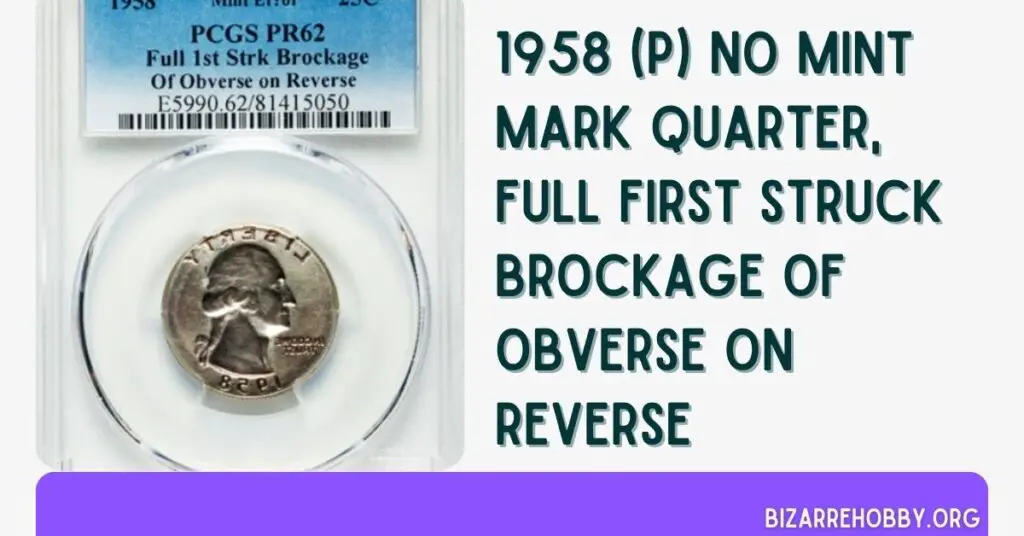
Occasionally, a planchet adheres to the die after being struck. When this occurs, it can imprint a mirror image of itself onto the next planchet, resulting in what’s known as a brockage error.
A remarkable example of this error occurred with a proof quarter struck in Philadelphia in 1958. The brockage manifested on the reverse, producing a mirror image of the obverse design. Consequently, Washington’s portrait appeared on both sides of the coin, with the reverse image appearing backwards.
This extraordinary error coin was graded PR62 by the PCGS and sold at auction for an astounding $12,000, highlighting the premium that collectors place on rare and unusual mint errors.
1958 (P) No Mint Mark Quarter, Struck On A Nickel Planchet
Another intriguing type of mint error occurs when a planchet intended for a different denomination finds its way into the coin press. This happened with a 1958 quarter struck in Philadelphia, which was mistakenly struck on a planchet meant for a Jefferson nickel.
As the nickel planchet is smaller than that of a quarter, this error resulted in a partial loss of the design. The upper portions of “LIBERTY” and the lower parts of the date were truncated. Furthermore, instead of the standard 6.3 grams for a silver quarter, this error coin weighed only 5 grams.
This unique error quarter was graded MS64 by the NGC, just shy of gem status. When offered at auction, it commanded a price of nearly $900, demonstrating the appeal of such dramatic mint errors to collectors.
Where to Sell Your 1958 Quarter?
Now that you’re equipped with knowledge about the value of your 1958 quarters, you might be wondering about the best places to sell them. Fortunately, there are numerous online platforms catering to coin collectors and sellers. Each site has its own strengths and potential drawbacks, which I’ve compiled into a comprehensive guide.
For a detailed overview of these platforms, including their features, advantages, and disadvantages, I recommend checking out our article: “Best Places To Sell Coins Online (Pros & Cons)“. This resource will help you make an informed decision about where to sell your valuable coins, ensuring you get the best possible return on your numismatic treasures.
FAQs on 1958 Quarter
Is a 1958 quarter all silver?
The 1958 quarter, like other quarters minted from 1932 to 1964, was composed of 90% silver and 10% copper.
How do I know if I have a rare 1958 quarter?
Check if the 1958 quarter has a mint mark, particularly the “D” (Denver) or no mint mark. Rare versions might have minting errors or high grades, so consider having it appraised by a professional.
Final Thoughts
The 1958 Washington quarter is more than just a piece of currency; it’s a tangible link to America’s past. Whether you’re an experienced numismatist or a curious newcomer, these coins offer a fascinating glimpse into mid-20th century American history and coin production.
From their 90% silver composition to the potential for valuable errors, 1958 quarters hold both intrinsic and collectible value. While most circulated examples are worth their weight in silver, uncirculated and error coins can command impressive premiums. As you examine your own 1958 quarters, remember that each coin tells a unique story – of the mint that struck it, the hands it passed through, and the economy it once served.
Whether you’re looking to start a collection, expand an existing one, or simply appreciate the artistry and history of these coins, the 1958 quarter is a worthy subject of attention. So, take a closer look at those old quarters in your change jar or family heirloom collection – you might just be holding a small piece of numismatic treasure.
